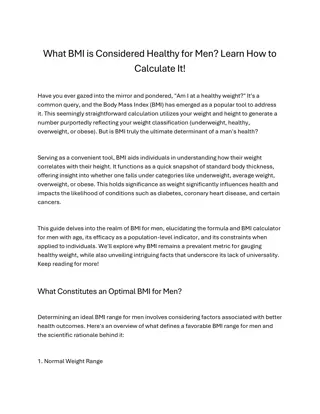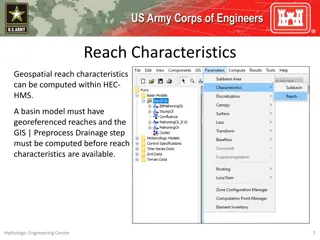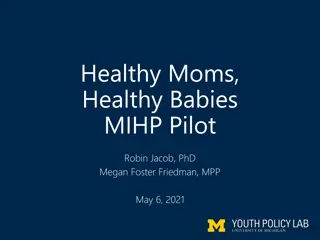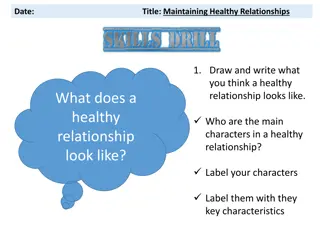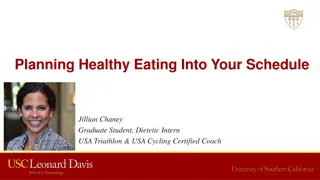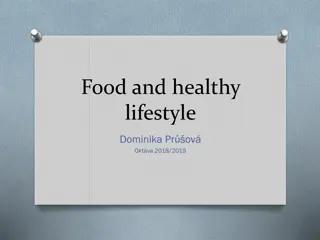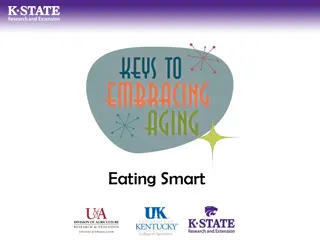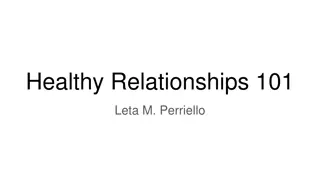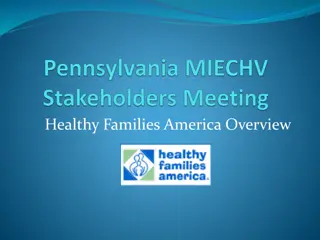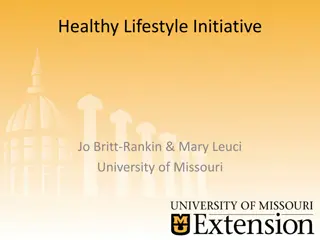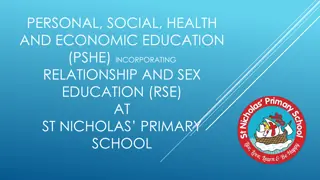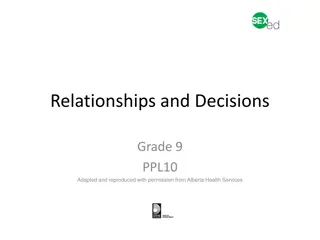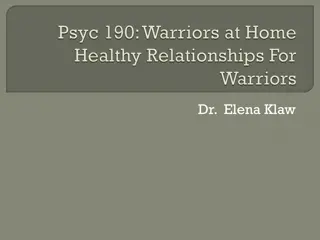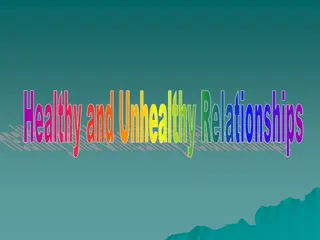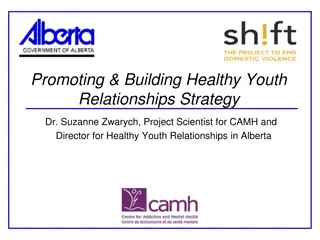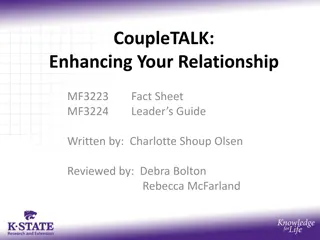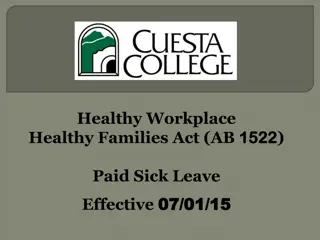Characteristics of a Healthy Relationship
A healthy relationship involves mutual respect, effective communication, trust, support, and shared values. It's about fostering growth, understanding, and happiness together, while also maintaining individual identities. Recognizing signs of domestic abuse is crucial for ensuring a safe and fulfilling relationship. Explore the key attributes of a positive partnership and learn to identify warning signs of unhealthy dynamics.
Download Presentation

Please find below an Image/Link to download the presentation.
The content on the website is provided AS IS for your information and personal use only. It may not be sold, licensed, or shared on other websites without obtaining consent from the author.If you encounter any issues during the download, it is possible that the publisher has removed the file from their server.
You are allowed to download the files provided on this website for personal or commercial use, subject to the condition that they are used lawfully. All files are the property of their respective owners.
The content on the website is provided AS IS for your information and personal use only. It may not be sold, licensed, or shared on other websites without obtaining consent from the author.
E N D
Presentation Transcript
List 5 characteristics of a healthy relationship
Assignments Due: 1. Marriage Interview DUE FRIDAY 20 points 2. Abstinence Program permission form DUE FRIDAY 50 points 3. Tuesday Feb 21, 2017 Today s Agenda: 20 points 50 points 1. Warm-Up 2. Pass out Abstinence program Permission forms 3. Watch Videos about Domestic Abuse 4. Pass out Marriage Interview Assignment 3. UNIT 3 TEST MONDAY UNIT 3 TEST MONDAY Essential Question: How can I recognize domestic abuse? Objective: I will be able to recognize the signs of domestic abuse in relationships.
Must have a form from EACH and EVERY student! DUE by FRIDAY, February 24th WORTH 50 points If you do not return a permission form or your parents do not wish for you to participate in the program, you will have an alternate assignment and will not be allowed to stay in the classroom. The program dates are Feb 28th March 9th
Must interview someone that has been married a MINUMIM of 5 years Parent, aunt, uncle, grandparent, neighbor, teacher, friend s parents, etc. DUE FRIDAY, February 24th
A. A condition in which two people depend on each other, yet each has a separate identity B. Violent treatment that results in physical injury to the victim C. Failure to provide proper care and guidance D. Verbally putting down another person E. A problem in which people neglect themselves to try to care for, control, or fix someone else F. A condition in which a person becomes obsessed with the needs of another person and can no longer recognize their own needs G. Sexual contact that is forced on another person H. A family that does NOT promote loving, responsible relationships I. A family that promotes loving, responsible relationships J. A deep and meaningful kind of sharing between two people 1. Neglect 2. Sexual Abuse 3. Physical Abuse 4. Interdependence 5. Healthful Family 6. Codependence 7. Emotional Abuse 8. Dysfunctional family 9. Enmeshment 10. Intimacy If you have your signed permission form please turn it in to the class basket
Assignments Due: 1. Abstinence Program permission form DUE FRIDAY 50 points 2. Wednesday Feb 22, 2017 Today s Agenda: 50 points 2. UNIT 3 TEST MONDAY UNIT 3 TEST MONDAY 1. Warm-Up 2. Grade and graph Unit 3 Pre- test 3. Pass back graded papers 4. Complete Unit 2 Tracking Sheet and turn it in 5. Start Unit 3 Notes Essential Question: How can I develop and maintain healthy relationships? Objective: I will be able to recognize the causes of dysfunction in relationships.
Must have a form from EACH and EVERY student! DUE by FRIDAY, February 24th WORTH 50 points If you do not return a permission form or your parents do not wish for you to participate in the program, you will have an alternate assignment and will not be allowed to stay in the classroom. The program dates are Feb 28th March 9th
4 = 10 3 = 8-9 2 = 6-7 1 = 5 0 = 4 or less
4 = 18-20 3 = 16-17 2 = 14-15 1 = 12-13 0 = 11 or less
4 = 20-22 3 = 18-19 2 = 16-17 1 = 14-15 0 = 13 or less
4 = 17-18 3 = 15-16 2 = 13-14 1 = 11-12 0 = 10 or less
4 = 29-32 3 = 26-28 2 = 23-25 1 = 20-21 0 = 19 or less
The basic unit of society is FAMILY Can include parents, brothers, sisters, aunts, uncles, grandparents, cousins, nephews, nieces, step- parents, step-brothers, or step-sisters
A HEALTHFUL FAMILY is a family that practices skills that promote loving, responsible relationships Have a positive effect on physical and emotional health
Skills such as: Self-respect Effective communication Values Coping skills Healthful attitudes Decision making skills Work ethic
A DYSFUNCTIONAL FAMILY is a family that does NOT promote loving, responsible relationships Dysfunction can be caused by many different problems, such as
1 Chemical dependence (drug addiction) Causes changes in behavior Increased risk for violence
2 Other addictions in the family Eating disorders, gambling addiction, workaholism, etc. Family life is neglected May lead to codependence
3 Perfectionism in the family Goes beyond having high standards Parents are overly critical Children feel inadequate and insecure Can lead to self-destructive behavior
4 Violence in the family The use of force to injure, damage, or destroy oneself, others, or property Domestic abuse Physical, sexual, or emotional abuse used by one person in a relationship to control the other Victims often blame themselves
5 Physical Abuse in the family (also #1 type of abuse) Def. - Violent Treatment that results in physical injury to the victim Abuser is usually controlling and moody Abuser usually feels guilty and apologizes after the abuse
6 Emotional Abuse in the family (also #2 type of abuse) Def. - Belittling or verbally putting down another person Making a person feel worthless Withholding love and affection in order to cause pain
7 Neglect (also #3 type of abuse) Def. - The inability or unwillingness of a parent, guardian or custodian of a child to provide that child with supervision, food, clothing, shelter or medical care if that inability or unwillingness causes unreasonable risk of harm to the child's health or welfare
8 Sexual Abuse (also #4 type of abuse) Def. - Any sexual contact that is forced on another person, either through physical force, manipulation, or threats of harm Can include: Inflicting or allowing sexual abuse Sexual conduct with a minor Sexual assault Molestation of a child Commercial sexual exploitation of a minor Sexual exploitation of a minor Incest Child prostitution
9 Abandonment in the family When a person chooses to give up or refuses responsibility for those in his or her care Can be physical abandonment parent leaves the home Can be emotional abandonment parent is not available and is emotionally absent Causes children to feel hurt and confused
10 Mental Disorders in the family A Family member with a mental disorder can cause additional stress for the family Family members may not be understanding and may not respond to the disorder in a supportive, helpful way
Codependent Relationships A problem when one person in a relationship neglect themselves to try to care for, control, or fix someone else Codependence is DYSFUNCTIONAL People who are codependent have trouble with intimacy INTAMACY a deep and meaningful kind of sharing between two people
Codependents avoid intimacy They may choose relationships that offer little or no chance for closeness Codependence Scale Enmeshment 100% Enmeshment 100% Interdependence 0% Interdependence 0%
Enmeshment a condition in which a person becomes obsessed with the needs of another person and can no longer recognize their own needs Interdependence a condition in which two people depend on each other, yet each maintains their own separate identity
Conversation Keepers Keepers Conversation Asking questions Showing interest in what someone is saying Listening carefully Responding to others Considering other ideas Encouraging another person Being positive Making eye contact
Conversation Killers Killers Conversation Talking ONLY about yourself Appearing disinterested in what someone is saying Interrupting someone Suddenly changing the topic Being a know-it-all Complaining Talking about other people behind their backs Avoiding eye contact
http://www.nbc.com/saturday-night- live/video/debbie-downer/n11825
A brief description of something or someone The following 10 profiles are brief descriptions of how people may relate to others in harmful ways These profiles help you understand ways harmful behaviors can sabotage your chance to have a healthful relationship
A person who constantly seeks the approval of others Do anything to be liked May engage in harmful behavior to fit in or be accepted Described as a doormat Lacks self-confidence Do not demand respect
A person who supports the harmful behavior of others Deny another person s harmful behavior Over look someone s addiction May make up excuses for that person May contribute to their harmful behavior
A person who is needy and dependent Feel empty inside Constantly turns to another person to feel better No amount of attention or affection keeps them feeling fulfilled Very demanding of others The other person usually starts to feel suffocated because they are not given any space
A person who tries to fix other peoples problems Takes on problems that are not their responsibility Quick to give advice They avoid their own problems by fixating on other people s problems
A person who is emotionally unavailable to others May have been hurt in the past Keeps people from getting too close They don t want to risk emotional involvement
A person who is possessive, jealous, and domineering Seeks power Tell the other person what to do and say and wear Does not like to share the object of their affection May lead to violent behavior Act like they own the other person in the relationship
A person who is self-centered Me, me, me They do most of the talking Does not show much interest in others Wants to do what they want, when they want They are not interested in other s opinions
A person who is abusive Cause others harm May threaten, start fights, or act in violent ways Follows abuse with periods of gentleness Abuse behavior returns
A person who does not tell the truth Not honest They lie about themselves to make themselves look good Relationships are based on lies Lack real connection They manipulate others into the responses they want
A person who is not reliable Make plans with someone, then be a no show Makes plans, then breaks them if something better comes along. They may agree to change their behavior, but they don t follow through Never keep their word Lacks sincerity and commitment
What percentage of teen marriages end in divorce?


![READ [PDF] Dash diet Cookbook for beginners: 365 days of simple, healthy, low-s](/thumb/2057/read-pdf-dash-diet-cookbook-for-beginners-365-days-of-simple-healthy-low-s.jpg)
